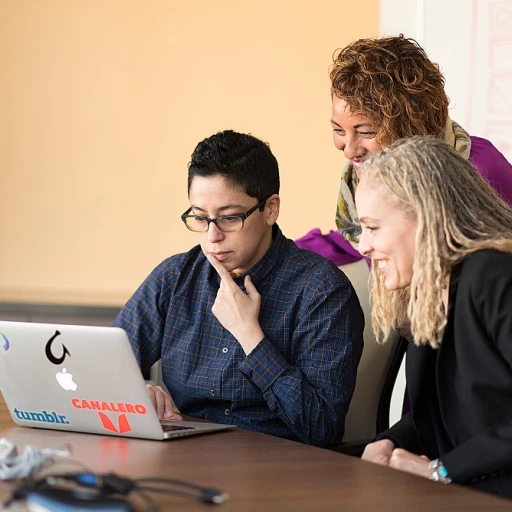
Understanding the Need for Transformation
The Imperative of Transforming HR Practices
In the rapidly changing world of human resources, the need for transformation is more pressing than ever. Organizations and their leaders are realizing that keeping pace with these changes can be the difference between thriving or merely surviving in the competitive landscape. While HR has always been about managing personnel and ensuring compliance, its role is now evolving into a more strategic one.
The stories of successful companies often reveal a similar tale. These companies' ability to adapt their HR practices in response to technological advances, cultural shifts, and economic changes highlights the importance of continual transformation. In this new era, the rise of fractional HR and other innovative concepts are leading the charge, helping organizations remain agile and efficient.
Change is inevitable, and HR transformation is a story that organizations must engage with sooner rather than later. By embracing new technologies and redefining employee experiences, HR departments are transforming how they operate. This transformation is not a one-time event but a continuous process that mirrors the ever-transforming nature of human life itself.
The classic tale of the "mad scientist" constantly working to improve their creations is not unlike the journey HR professionals are on today. They are experimenting with new tools and strategies to transform their organizations from within. As employees, leaders, and HR professionals embark on this transformation story, they must pay attention to the shifts in corporate culture, employee expectations, and the global market.
In addressing the need for transformation, one must consider the body and mind of the organization. Just as a "girl turned princess" in a fairy tale must adapt to her new life, businesses must adjust to their evolving corporate landscapes. It’s an ongoing journey, with challenges akin to those in the "legend zelda," where the path is uncertain but ultimately rewarding.
Leveraging Technology for HR Innovation
A New Dimension in Human Resources
The story of technology in human resources is akin to a transformation story from literature, where the mundane is infused with a spark of innovation, forever altering its existence. HR professionals have started leveraging technology not just for efficiency but also as a catalyst for change in how employee interactions and processes unfold. This transformation is a testament to how advancements in tech are turning traditional methods into streamlined operations. Just as fairy tales speak of magical transformations, the adaptation of technological solutions has rewritten HR strategies across the globe.
With the emergence of data analytics, AI, and cloud computing, many HR departments are embracing these tools to streamline operations. There's an evolution happening that almost feels fictional, as HR activities transition into seamless, automated processes.
Technology: The Change Maker
Technology acts as a bridge, connecting the world of HR with the aspirations of the workforce, much like how a mad scientist's invention transforms life in stories. It has provided HR with night vision insights, illuminating trends and needs that were once shrouded in ambiguity. By deploying data-driven solutions, companies now understand employee preferences and can craft personalized experiences that go beyond transactional interactions.
As we trace the lineage of innovations, we see tech changing the fabric of recruitment, onboarding, and training. These areas, which were bound by traditional conventions, have now turned into dynamic segments where the body and mind can thrive. Such transformation stories illustrate the possibility of change when technology and human resources join forces.
- Cloud Platforms: The transformation from physical archives to story archive-like digital repositories has reimagined how HR departments store and retrieve information.
- AI in Recruitment: By redefining candidate experiences, artificial intelligence acts as a guide in the story of recruitment, navigating through data to find the right fit.
- Analytics: The tale of insights is being rewritten with analytics playing a crucial role in identifying trends and making strategic decisions for the future.
HR leaders are encouraged to spend time understanding these tools to enhance their department's efficiency and effectiveness. A well-implemented technological transformation can lead to a significant positive impact on the organization's overall success. For those interested in the intersection of technology and strategy within HR, crafting effective IT governance can provide further insights into successful integration strategies.
Redefining Employee Experience
Crafting a Memorable Employee Journey
In the dynamic landscape of Human Resources, the notion of enhancing the employee experience has become a focal point for organizations aiming for transformation. The stories that unfold within a company's walls are as diverse as life itself, embodying a rich tapestry of change, growth, and exploration. To redefine the employee experience effectively, think about it as crafting a legend that doesn't lack the excitement of a fiction genre. A modern-day fairy tale, if you will, where individuals can write their stories, blending professional growth with personal satisfaction. Consider it not just as a transformation of roles, but a deeper evolution that impacts body mind alignment and even the immune system of the workplace, creating a sustainable and engaging environment.- Technology as a Muse: The integration of technological advancements, similar to that of the evolution of sleep innovation, can act as a catalyst, furthering our understanding of employee needs. Through solutions like digital engagement platforms and automation, organizations can provide employees with tools that enhance connectivity and support their professional journeys.
- Mindful Leadership: Leaders play a pivotal role in the story transformation of the employee experience. By fostering an environment of trust, empathy, and open communication, they create a culture where individuals feel valued. Key to this change is transforming leadership styles to focus more on human elements, reminiscent of the narrative arch in timeless fairy tales.
- Tailored Employee Growth Plans: Just like a mad scientist meticulously develops a new experiment, organizations must tailor growth plans to meet individual needs. By spending time understanding each person’s aspirations, companies can turn ambitions into reality, enhancing engagement and loyalty.
- Designing Flexible Work Environments: With the advent of hybrid work models, HR must continuously adapt to provide employees with options that cater to their lives outside of work, akin to the versatility of a princess navigating through diverse worlds. This consideration helps maintain a healthy life-work balance while fostering creativity and innovation.
The Role of Leadership in Driving Change
Driving Change: The Leadership Perspective
The journey of innovation in human resources is heavily influenced by leadership. When we talk about change, it’s not just a transformation on paper. It’s a comprehensive overhaul of how we perceive work, love our job, and narrate the stories that define our career paths. Much like a well-written story archive or a fairy tale, the leadership's role is pivotal in turning challenges into opportunities. A vital component of this transformation story is that leaders need to have a clear vision and champion change by setting the tone for a mind shift. Just as a princess in a legend like Zelda, leaders must embark on a quest, albeit not fictional, to align the values of the organization with the innovative strides in human resources. This alignment involves a mix of empathy, strategic thinking, and an unwavering commitment to employee welfare. Indeed, change management requires leaders to pay attention to the stories of their teams. Embracing stories archive or stories transformation allows leaders to understand their teams' needs better, fostering an environment where employees feel heard and valued. In this archive of corporate wisdom, each story written by employees adds to the collective growth of the organization. It's the leaders who encourage a culture where transformation is not feared but rather welcomed, akin to a mad scientist excited about an experiment with life-changing possibilities. They invest time in ensuring that physical transformations within the company correlate with positive impacts on the body mind and immune system of their workforce. Much like the night vision needed to navigate through uncharted waters, leaders are the torchbearers, illuminating the path to success. To drive transformation stories effectively, leadership needs to maintain a balance between traditional practices and modern innovations, aware that the journey will be rife with challenges. This necessitates a continuous commitment to growth, drawing inspiration from stories of change while adapting strategies that cater to the dynamic landscape of human resources.Challenges in Implementing HR Innovations
Overcoming Hurdles in HR Innovation
The journey of transformation in human resources, much like any transformative story, comes with its own set of challenges. The human element is at the core of these challenges, as change can often trigger resistance. Innovation in HR requires changing mindsets and redefining conventional ideas about employee engagement and experience. A story written about the evolution of workplace culture often underscores the delicate balance HR must maintain between technological advancement and human connection.
As HR departments strive to implement forward-thinking solutions, they frequently encounter roadblocks that hinder progress:
- Resistance to Change: Transforming existing HR processes involves altering the traditional practices that employees have grown accustomed to over the years. Like a character in a fairy tale resisting their destined path, companies must address these resistances and turn them into opportunities for growth and innovation.
- Data Privacy Concerns: With the advent of technology and data-driven solutions, protecting employee data has become paramount. Maintaining trust while implementing innovative strategies is vital, as the balance between security and efficiency needs to be continually managed.
- Integration and Compatibility: The integration of new HR technologies can sometimes resemble the stories of mad scientists trying to perfect their experiments. Ensuring compatibility with existing systems and processes can be a daunting task, requiring meticulous planning and execution.
- Maintaining Work-Life Balance: Innovation should not come at the cost of employee well-being. HR leaders must ensure that new strategies prioritize the physical and mental health of employees, akin to prioritizing love and life in a well-written fiction genre.
Each transformation story in the HR realm is unique, echoing legends and tales that speak to the heart of change and adaptation. The TSA (transformative strategic alignment) plays an indispensable role in ensuring all members of an organization move forward in concert. Embracing transformation, while cultivating an environment that supports both mind and body, will turn these challenges into catalysts for lasting, impactful change.












